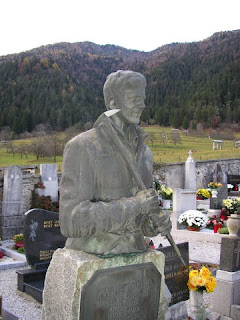
Rain woke us at approx. 6 o'clock and continued for most of the morning, degenerating into hail and sleet for some of the time. Unsurprisingly, we decided to have a relaxing day based around the campsite.
After lunch, the weather improved – it was still very cold, especially in the wind, but it was dry. It was also clear that the rain overnight and this morning had fallen as snow on the mountains and all of the peaks had a white covering. We decided to investigate the local village of Dovje, which is only a few minutes walk from the campsite. The village has a large number of farms in it with many huge barns with the sound of cattle emanating from them. Many of the buildings are old, dating from the 18th century and the architecture is intriguing. Our local Somerset painter, Michael Cooper, would really enjoy painting the farmyard and farm building scenes.
Triglev mountain is a national symbol for the Slovenes and one of their heroes is Jacob Aljaz (1845 – 1927) who was the Dovje parish priest for 38 years. In addition to being a successful composer, he was a very keen mountain walker and climber. He had mountain paths and huts built in the area and the metal turret on the summit of Triglev is named Aljazev Stolp after him. With his country under occupation by the Austrian empire and with competing claims for Triglev by Austria and Germany, Aljaz bought peak of Triglev for 1 florin in 1895 to ensure that Triglev remained Slovenian. We visited the Dovje church and saw his grave and the very large graveyard. Many climbers killed on Triglev are buried in the churchyard.
We arrived back at Henrietta very cold but the lovely sunset suggested that tomorrow would be a fine day.
We had decided to stay at Camping Kamne for another two nights so we went down to the bar to pay. Although we were the only guests, the site also has caravans that stay all year and the owners come to the site, mainly from Ljubljana, every weekend. For this reason, the bar is opened for a couple of hours on Friday and Saturday evenings out of season. We had a very pleasant hour chatting with Ana, the owner's daughter, who works full-time at the campsite. Her English was extremely good and it was great to talk to her about life in Slovenia, local places of interest and many other things. Ana is also fluent in German but says that she has to re-learn Italian every year because they don't have many Italian guests. She said that she didn't want too many Italians because they are “too loud”. We had to agree with her given our experience in Ljubljana!
Photos: Dovje churchyard – gravestone of Zvone Kofler aged 26 described as 'Alpinist from Mojstrana'.
After lunch, the weather improved – it was still very cold, especially in the wind, but it was dry. It was also clear that the rain overnight and this morning had fallen as snow on the mountains and all of the peaks had a white covering. We decided to investigate the local village of Dovje, which is only a few minutes walk from the campsite. The village has a large number of farms in it with many huge barns with the sound of cattle emanating from them. Many of the buildings are old, dating from the 18th century and the architecture is intriguing. Our local Somerset painter, Michael Cooper, would really enjoy painting the farmyard and farm building scenes.
Triglev mountain is a national symbol for the Slovenes and one of their heroes is Jacob Aljaz (1845 – 1927) who was the Dovje parish priest for 38 years. In addition to being a successful composer, he was a very keen mountain walker and climber. He had mountain paths and huts built in the area and the metal turret on the summit of Triglev is named Aljazev Stolp after him. With his country under occupation by the Austrian empire and with competing claims for Triglev by Austria and Germany, Aljaz bought peak of Triglev for 1 florin in 1895 to ensure that Triglev remained Slovenian. We visited the Dovje church and saw his grave and the very large graveyard. Many climbers killed on Triglev are buried in the churchyard.
We arrived back at Henrietta very cold but the lovely sunset suggested that tomorrow would be a fine day.
We had decided to stay at Camping Kamne for another two nights so we went down to the bar to pay. Although we were the only guests, the site also has caravans that stay all year and the owners come to the site, mainly from Ljubljana, every weekend. For this reason, the bar is opened for a couple of hours on Friday and Saturday evenings out of season. We had a very pleasant hour chatting with Ana, the owner's daughter, who works full-time at the campsite. Her English was extremely good and it was great to talk to her about life in Slovenia, local places of interest and many other things. Ana is also fluent in German but says that she has to re-learn Italian every year because they don't have many Italian guests. She said that she didn't want too many Italians because they are “too loud”. We had to agree with her given our experience in Ljubljana!
Photos: Dovje churchyard – gravestone of Zvone Kofler aged 26 described as 'Alpinist from Mojstrana'.
No comments:
Post a Comment